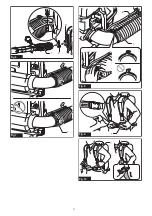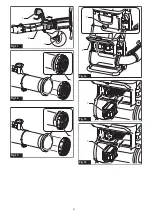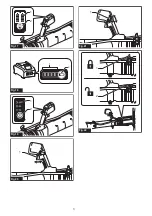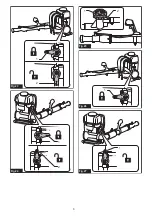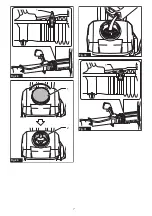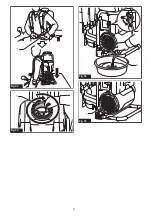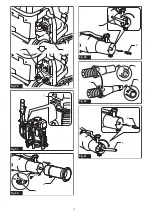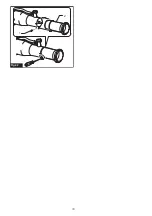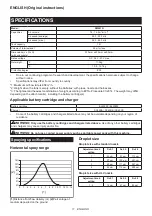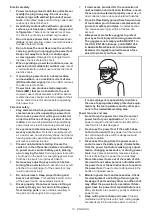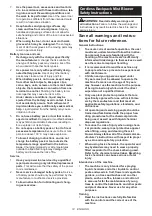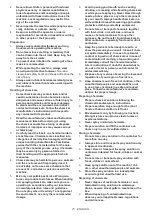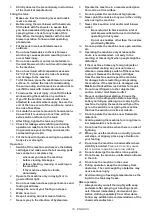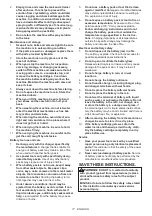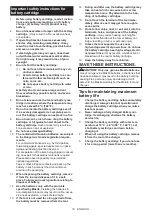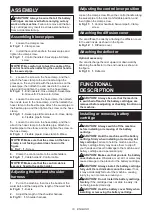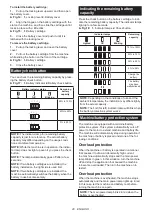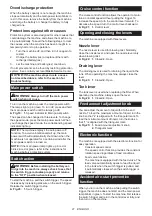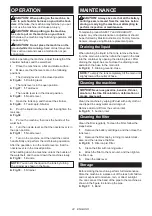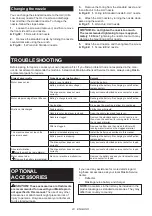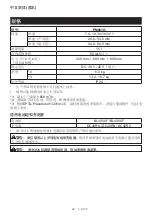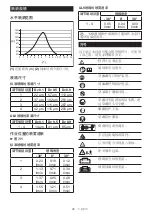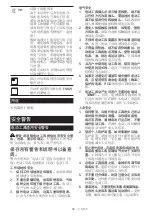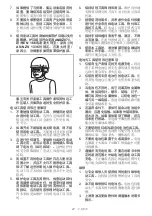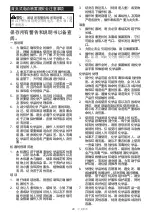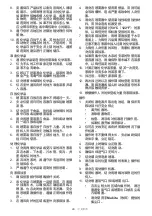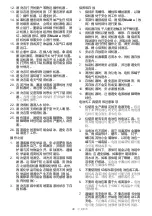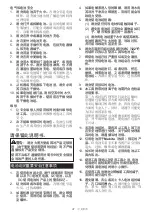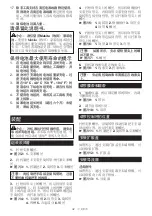
17 ENGLISH
2.
Empty, rinse and clean the tank and strainer
after each use. This helps to prevent the
solution from crystallizing, which could later
cause clogging and chemical damage to the
machine. In addition, residual chemicals may
have undesirable effects during subsequent
spraying with a different type of chemical (e.g.,
residual herbicide may damage or kill plants
being sprayed with a pesticide).
3.
Do not store the machine with spray solution
in the tank.
Maintenance and storage
1.
Keep all nuts, bolts and screws tight to be sure
the machine is in safe working condition.
2.
If the parts are worn or damaged, replace them
with parts provided by Makita.
3.
Store the machine in a dry place out of the
reach of children.
4.
When you stop the machine for inspection,
servicing, storage, or changing accessory,
switch off the machine and make sure that all
moving parts come to a complete stop, and
remove the battery cartridges. Cool down
the machine before making any work on the
machine. Maintain the machine with care and
keep it clean.
5.
Always cool down the machine before storing.
6.
Do not expose the machine to rain. Store the
machine indoors.
7.
When you lift the machine, be sure to bend
your knees and be careful not to hurt your
back.
8.
When washing the machine, do not let water
enter the electrical mechanism such as bat-
tery, motor, and terminals.
9.
When storing the machine, avoid direct sun-
light and rain, and store it in a place where it
does not get hot or humid.
10.
When carrying the machine, be sure to hold
the machine firmly.
11.
When carrying the machine, be careful not to
get the cord caught by obstacles.
Battery tool use and care
1.
Recharge only with the charger specified by
the manufacturer.
A charger that is suitable for
one type of battery pack may create a risk of fire
when used with another battery pack.
2.
Use power tools only with specifically desig
-
nated battery packs.
Use of any other battery
packs may create a risk of injury and fire.
3.
When battery pack is not in use, keep it away
from other metal objects, like paper clips,
coins, keys, nails, screws or other small metal
objects, that can make a connection from one
terminal to another.
Shorting the battery termi
-
nals together may cause burns or a fire.
4.
Under abusive conditions, liquid may be
ejected from the battery; avoid contact. If con-
tact accidentally occurs, flush with water. If
liquid contacts eyes, additionally seek medical
help.
Liquid ejected from the battery may cause
irritation or burns.
5.
Do not use a battery pack or tool that is dam-
aged or modified.
Damaged or modified batteries
may exhibit unpredictable behaviour resulting in
fire, explosion or risk of injury.
6.
Do not expose a battery pack or tool to fire or
excessive temperature.
Exposure to fire or tem
-
perature above 130 °C may cause explosion.
7.
Follow all charging instructions and do not
charge the battery pack or tool outside the
temperature range specified in the instruc
-
tions.
Charging improperly or at temperatures
outside the specified range may damage the
battery and increase the risk of fire.
Electrical and battery safety
1.
Do not dispose of the battery(ies) in a fire.
The cell may explode. Check with local codes for
possible special disposal instructions.
2.
Do not open or mutilate the battery(ies).
Released electrolyte is corrosive and may cause
damage to the eyes or skin. It may be toxic if
swallowed.
3.
Do not charge battery in rain, or in wet
locations.
4.
Do not charge the battery outdoors.
5.
Do not handle charger, including charger plug,
and charger terminals with wet hands.
6.
Do not replace the battery with wet hands.
7.
Do not replace the battery in the rain.
8.
Do not wet the terminal of battery with liquid
such as water, or submerge the battery. Do not
leave the battery in the rain, nor charge, use,
or store the battery in a damp or wet place.
If
the terminal gets wet or liquid enters inside of bat
-
tery, the battery may be short circuited and there is
a risk of overheat, fire, or explosion.
9.
After removing the battery from the machine or
charger, be sure to store it in a dry place.
10.
If the battery cartridge gets wet, drain the
water inside and then wipe it with a dry cloth.
Dry the battery cartridge completely in a dry
place before use.
Service
1.
Have your power tool serviced by a qualified
repair person using only identical replacement
parts.
This will ensure that the safety of the power
tool is maintained.
2.
Never service damaged battery packs.
Service
of battery packs should only be performed by the
manufacturer or authorized service providers.
SAVE THESE INSTRUCTIONS.
WARNING:
DO NOT let comfort or familiarity
with product (gained from repeated use) replace
strict adherence to safety rules for the subject
product.
MISUSE or failure to follow the safety rules stated
in this instruction manual may cause serious
personal injury.
Содержание PM001G
Страница 2: ...2 0 30 30 Fig 1 1 Fig 2 1 2 3 Fig 3 6 1 2 3 4 5 Fig 4 2 1 4 3 5 Fig 5 ...
Страница 3: ...3 3 2 1 Fig 6 1 Fig 7 1 2 Fig 8 1 Fig 9 1 Fig 10 ...
Страница 4: ...4 1 2 3 Fig 11 1 Fig 12 1 Fig 13 1 2 Fig 14 1 Fig 15 1 Fig 16 ...
Страница 5: ...5 1 2 Fig 17 1 2 Fig 18 1 2 Fig 19 1 Fig 20 1 Fig 21 1 2 Fig 22 ...
Страница 6: ...6 1 2 Fig 23 1 2 Fig 24 2 1 Fig 25 1 Fig 26 1 Fig 27 ...
Страница 7: ...7 1 Fig 28 1 2 Fig 29 Fig 30 1 Fig 31 ...
Страница 8: ...8 1 Fig 32 1 Fig 33 1 2 Fig 34 1 Fig 35 ...
Страница 9: ...9 2 1 Fig 36 1 Fig 37 1 2 Fig 38 1 2 Fig 39 1 2 3 Fig 40 1 2 Fig 41 ...
Страница 10: ...10 1 2 Fig 42 ...
Страница 99: ...99 ...

